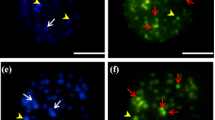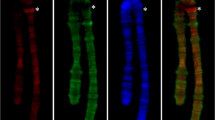Abstract
A bisexual species of the genus Artemia (Crustacea, Phyllopoda), Artemia franciscana Barigozzi of San Francisco Bay and a parthenogenetic population of Artemia sp. of Tsing-Tao (China), both with 42 chromosomes, were compared with respect to the microscopic structure of the interphase larval nucleus, the microscopical structure of the prophase chromosomes and the DNA structure. — Artemia franciscana exhibits several chromocenters in the resting nucleus, heterochromatic blocks located at the end of the prophase chromosomes, and a large amount of repetitive DNA (Alu I 110-bp fragments). The other Artemia sp. lacks chromocenters, heterochromatic blocks in the chromosomes, and the Alu I DNA. The two populations thus differ by a remarkable amount of repetitive DNA.
Similar content being viewed by others
References
Abreu-Grobbois FA, Beardmore A (1982) Genetic differentiation of the brine shrimp Artemia. In: Mechanisms of speciation. Liss, New York, 347–375
Barigozzi C (1974) Artemia: A survey of its significance in genetic problems. Evol Biol 7:221–252
Holmes DS, Quigley M (1981) A rapid boiling method for the preparation of bacterial plasmids. Anal Biochem 114:193–197
Maniatis T, Fritsch EF, Sambrook J (1982) Molecular cloning. A laboratory manual. Cold Spring Harbor Laboratory
Messing J, Crea R, Seeburg PH (1981) A system for shotgun DNA sequencing. Nucleic Acids Res 9:309–321
Radloff R, Bauer W, Vinograd (1967) A dye buoyant density method for the detection and isolation of closed circular duplex DNA: the closed circular DNA in HeLa cells. Proc Natl Acad Sci 57:1514–1518
Rigby PWJ, Dieckmann H, Rhodes C, Berg P (1977) Labeling deoxyribonucleic acid to high specific activity in vitro by nick translation with DNA polymerase I. J Mol Biol 113:237–251
Southern EM (1975) Detection of specific DNA sequences among DNA fragments separated by gel electrophoresis. J Mol Biol 98:503–527
Stefani R (1963a) La digametia femminile in Artemia salina Leach e la constituzione del corredo cromosomico nei biotipi anfigonico e partenogenetico. Caryologia, 16:625–636
Stefani R (1963b) Il centromero non localizzato in Artemia salina Leach. Acc Naz Lincei Rend Cl Sci Fis Mat Nat 35:375–378
Taback HF, Flavell RA (1978) A method for the recovery of DNA from agarose gels. Nucleic Acids Res 5:2321–2332
Vieira J, Messing J (1982) The pUC plasmids, and M13mp7-derived system for insertion mutagenesis and sequencing with synthetic universal primers. Gene 19:259–268
Author information
Authors and Affiliations
Additional information
The authors dedicate this paper to Professor Hans Bauer, on the occasion of his 80th birthday
Rights and permissions
About this article
Cite this article
Barigozzi, C., Badaracco, G., Plevani, P. et al. Heterochromatin in the genus Artemia . Chromosoma 90, 332–337 (1984). https://doi.org/10.1007/BF00294159
Received:
Issue Date:
DOI: https://doi.org/10.1007/BF00294159




